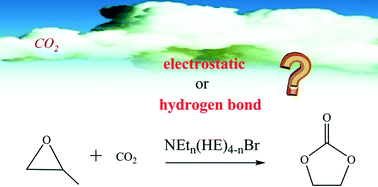Quaternary ammonium-based ionic liquids bearing different numbers of hydroxyl groups as highly efficient catalysts for the fixation of CO2: a theoretical study by QM and MD†
Abstract
The mechanism of coupling reactions of carbon dioxide (CO2) with propylene oxide (PO) catalyzed by a series of hydroxyl-functionalized quaternary ammonium-based ionic liquids (ILs) is investigated by the combination of density functional theory (DFT) and molecular dynamics (MD) methods. The calculated sequence of catalytic activity conflicts with the experimental result if only a single catalyst is considered, which is attributed to the fact that the influence of other hydroxyl groups in the cation is ignored. To include the contribution from multi-hydroxyl groups in the cation, the mechanism is investigated using a model catalyzed by two quaternary ammonium-based ion pairs. Noncovalent interaction (NCI) analysis is utilized as a tool to investigate this phenomenon. Additionally, 256 ion pairs are simulated to further confirm the accuracy of the two-catalyst model. It is expected that this work will open a new pathway to explore the mechanism especially for ionic liquids including multi-functionalized groups.


 Please wait while we load your content...
Please wait while we load your content...